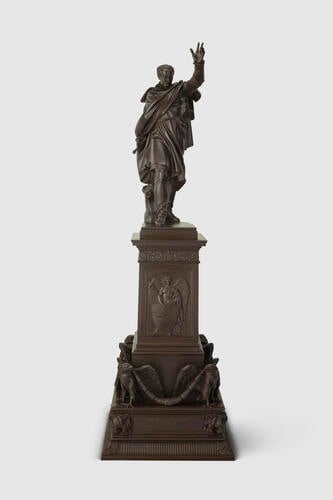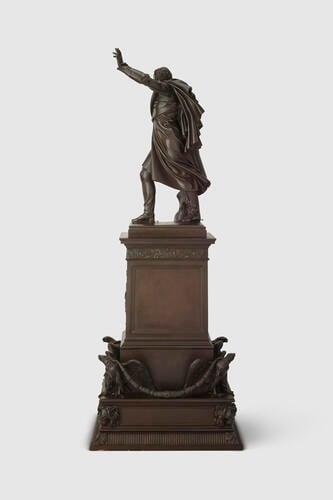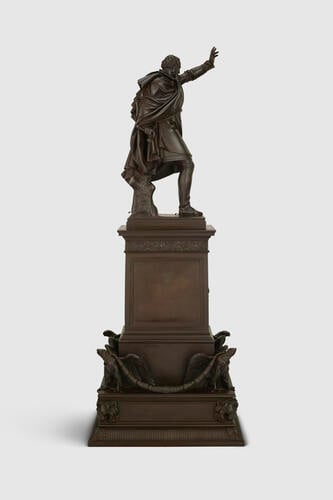Field Marshal Prince Gebhard von Blücher (1742-1819) signed and dated 1825
Iron | 143.5 x 55.0 x 46.0 cm (whole object) | RCIN 31164

Christian Daniel Rauch (1777-1857)
Field Marshal Prince Gebhard von Blücher (1742-1819) signed and dated 1825

Christian Daniel Rauch (1777-1857)
Field Marshal Prince Gebhard von Blücher (1742-1819) signed and dated 1825

Christian Daniel Rauch (1777-1857)
Field Marshal Prince Gebhard von Blücher (1742-1819) signed and dated 1825




-
Cast iron statue of Field Marshal Blücher, stepping forward, with left arm raised. Mounted on a square stepped plinth with, at each corner, double-headed eagles each holding a continuous garland and recumbant lions at the base.
Marked:
On the shield at the front of the base held by a winged figure: MIT GOT FUR / KONIG UND / FATERLAND [With God for King and Fatherland]
At the front of the plinth: DEM FELD HERREN BLÜCHER / UND DEM / HEERE / DIE SCHLEISER [To Field Marshal Blucher and the Silesian Army]
On front edge: Gegossen auf den Konig: Eisengießerei bei Berlin 1825 [Cast at the Royal Iron Foundry, Berlin, 1825]Provenance
Gebhard Leberecht von Blücher, Fürst von Wahlstatt (1742-1819) was the Prussian Generalfeldmarschall who led his army against Napoleon at the Battle of the Nations, alongside Russian, Swedish and Austrian allies, at Leipzig in 1813 and the Battle of Waterloo in 1815.
Following Napoleon's return from Elba, Blücher commanded the Army of the Lower Rhine. In the June 1815 campaign he sustained a serious defeat at Ligny on 16 June, just two days before the decisive battle at Waterloo. In the course of this battle he was seriously wounded but recovered sufficiently to rejoin his troops, despatching two corps to join Wellington and then led the remainder of his men, arriving on the battlefield in the late afternoon. With the battle hanging in the balance his army intervened with decisive and crushing effect; his vanguard drew off Napoleon's reserves and crushed the remains of French resistance leading the way to a decisive victory. The Prussians followed with a relentless pursuit of the retreating Armée du Nord.
In the evening, after the battle, Wellington and Blücher met close to the inn at La Belle Alliance where Napoleon had abandoned his headquarters. During the meeting Blücher suggested the battle should be remembered as La Belle Alliance, to commemorate the European coalition formed to defeat the French Emperor. Wellington instead recommended Waterloo, the village just north of the battlefield, where he had spent the previous night, commenting that it would not do to name the battle after the Emperor's command post.
Christian Daniel Rauch founded the Berlin school of sculpture and was the foremost German sculptor of the nineteenth century. This is a reduced copy of the huge statue cast in 1824 at the Royal Prussian Iron Foundry in Berlin, founded in 1804. The original was displayed in the city of Breslau. The use of iron, rather than imperial bronze, is not surprising; it is more than just a material - it was the substance of the Prussian nation - Iron Cross, Iron Chancellor. To paraphrase Neil MacGregor 'this was Berlin, a court notorious for its ostentatious eschewal of luxury ... in Prussia the nation itself was personified in iron: no frippery, no nonsense. This was the Iron Nation' [with] 'citizens united, understated and resolved'.
This copy was acquired by the Earl of Clanwilliam (Minister at Berlin at the time) on behalf of George IV. The Earl wrote to Sir William Knighton, the King's Private Secretary, on 23rd June 1825 that he had visited 'the iron foundry, where I found the statue and pedestal of Blücher's monument at Breslau in great forwardness ... The case will be sent off by water in a fortnight and may reach London in a month or more - say the beginning of September'. Recorded as received in London 17 September 1825 (Jutshams Receipts II 207) 'iron cast of Blücher & pedestal'. Sent to Windsor Castle on 28th November 1828.
Identical examples of this reduced copy and bearing the same inscription at the front, are in the collections at Corsham Court in Wiltshire and the Wellington Museum at Apsley House. -
Creator(s)
(founder (metals))Acquirer(s)
-
Medium and techniques
Iron
Measurements
143.5 x 55.0 x 46.0 cm (whole object)
Category








